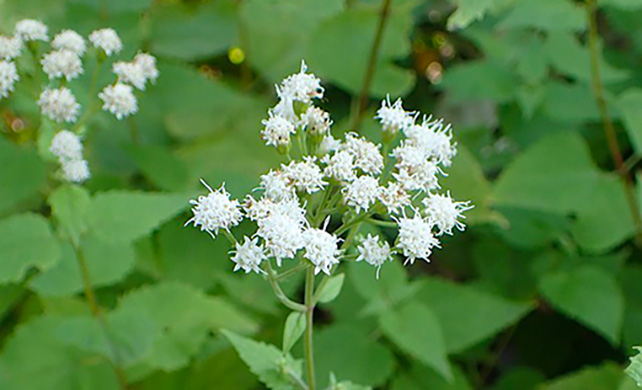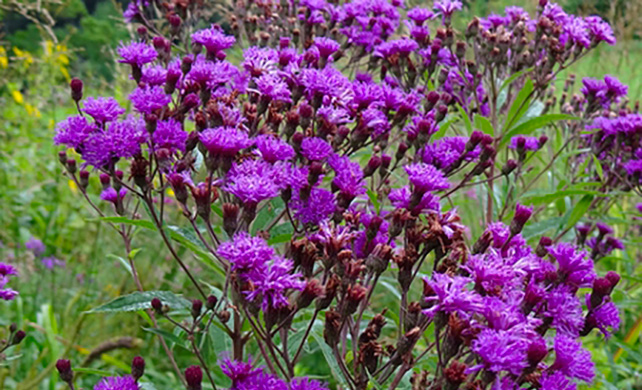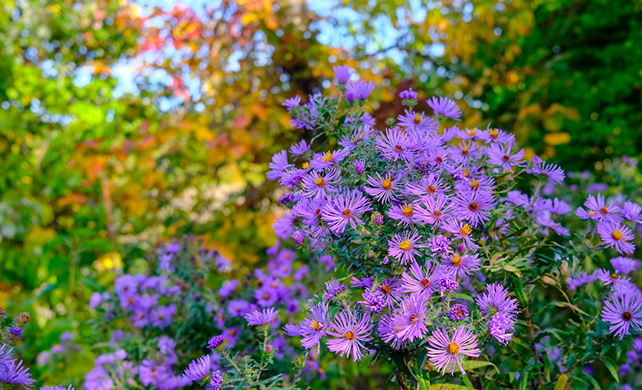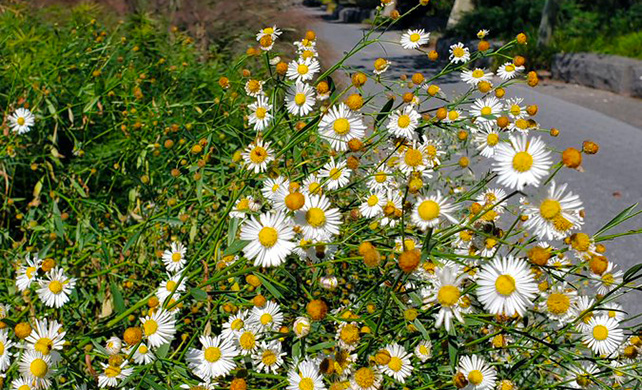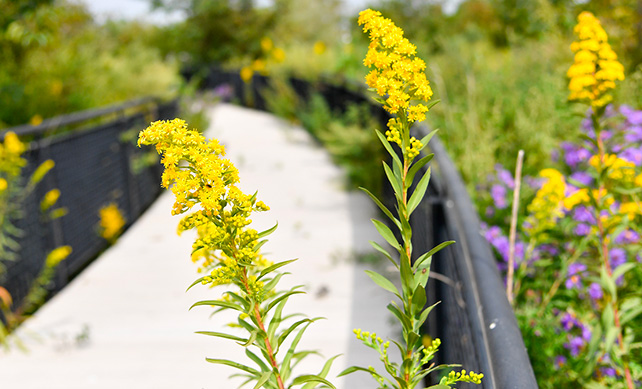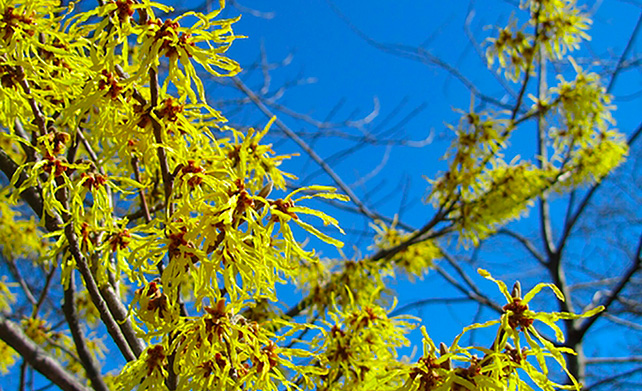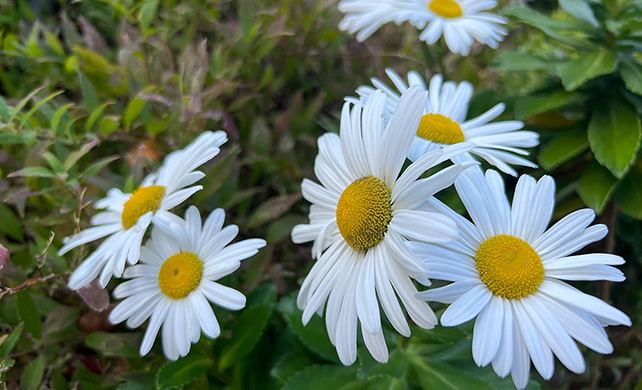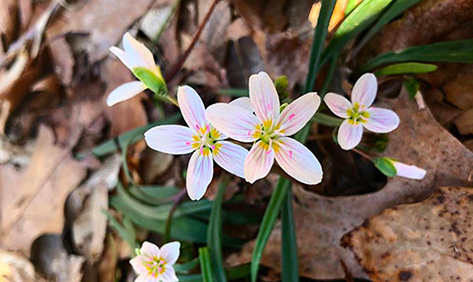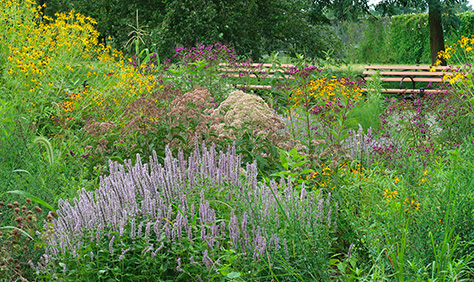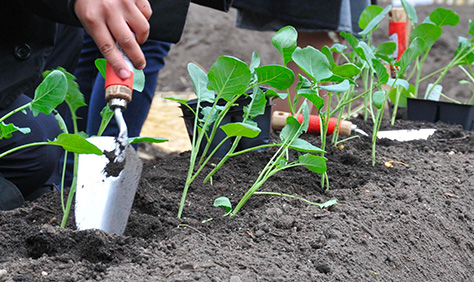Native Plants of New York City: Fall Blooming Plants
While trees and their red and orange fall foliage get most of the attention, they’re not the only source of bright colors in nature this time of year. Our parks and gardens are full of plants that flower in vibrant bursts of purple, gold, and white, bringing color to the landscape and providing food and habitat for pollinators.
Many of New York City’s perennials, plants that are able to grow and survive for multiple growing seasons, bloom in the late summer and fall. The showy flowers attract important pollinators like bees, butterflies, wasps, and more. Migrating pollinators collect food to fuel their journey and pollinators that spend the winter in NYC are able to stock their nests with food so that the new insects that emerge in the spring don’t go hungry before the spring flowers grow.
* Click on images to view larger
Check out some of our “late bloomers”!
Common White Snakeroot
The common white snakeroot (Ageratina altissima) blooms from July to October, with white inflorescences (bunches of small flowers) visible throughout the fall. The nectar of these flowers attracts a variety of insects, including leaf-cutting bees, butterflies, wasps, and moths. The caterpillars of some moths, including Eupatorium Borer Moth (Carmenta bassiformis) and Ruby Tiger Moth (Phragmatobia fuliginosa), feed on the foliage of white snakeroot and related plants.
New York Ironweed
New York ironweed (Vernonia noveboracensis) is a towering upright perennial wildflower that is native to the eastern and southeastern U.S. It is commonly found in areas with wet soil, like streambanks, low-lying woods, and marshes. It blooms in the late summer through early fall with fluffy, deep purple composite flowers, 3 to 4 inches wide, that cluster at the top of the plant above long, lance-shaped leaves.
Asters
Asters are a family of flowers that are daisy-like in appearance and are very popular in gardens because they attract pollinators and come in a variety of colors. Here are a couple of our favorites are:
-
New England Aster (Symphyotrichum novae-angliae): The New England Aster blooms from September to October with vibrant purple ray flowers that have bright yellow to orange disk flowers in the center. This aster has more ray flowers than other asters in our area! It has hairy leaves that clasp the stem, helping make it easy to identify. It prefers partial shade, but can also be found in moist meadows and woodland edges. It is an important nectar resource for native bees and a larval host for the Pearl Crescent butterfly (Phyciodes tharos).
-
White Wood Aster (Eurybia divaricata): The white wood aster can be found in our woodlands and woodland edges blooming a brilliant white from September to November. Its leaves, which emerge in late spring, are heart shaped or cordate.
Goldenrods
Goldenrods are some of the most recognizable fall-blooming plants. Their towering stalks feature large, yellow flowers that are particularly attractive to monarch butterflies.
Seaside goldenrod (Solidago sempervirens), for example, can grow to six feet tall and is one of the most critical resources for monarch butterflies migrating through our coastal areas. This plant is aptly named, as its natural salt tolerance allows it to survive in salty seaside locations, like dunes and the upper edges of salt marshes. In fact, it has even found a lot of new habitats in NYC where we salt roadways in the winter! Some botanists have nominated it as the toughest plant in NYC!
Witch-hazel
Keep an eye out for witch-hazel (Hamamelis virginiana), a native plant that blooms with yellow flowers as late as November, book-ending the winter season with its spring-blooming cousin, Hamamelis mollis. Witch hazel even has small brown nuts that provide food for wildlife.
Montauk Daisies
How You Can Help
Want to help these plants and the pollinators who need them?
- Volunteer with our Stewardship Team! You'll help remove harmful plant species at our parks in order to restore habitat for fall-blooming plants.
- Plant local, native plants in your yard or on your windowsill, or encourage your community to use more native plants in their greenspaces. To learn more about native plants, check out the Native Species Planting Guide of New York City [PDF].
Explore More
Head out into our parks and garden spaces to see these flowers in person and learn how to grow your own!
Native Plants in New York City
Take a look at some of the plants that grow wild in the NYC area and learn how we're growing more of these plant species to grow sustainable parks!
Pollinator Place Gardens
Some of our year-round gardens are dedicated to providing food and shelter for pollinators, including bees and butterflies. These gardens can be found across NYC.
Gardening Workshops
Looking to start gardening? Meet up with expert gardeners, including our friends at our GreenThumb community gardens, to learn tips and tricks for growing greenspaces.

